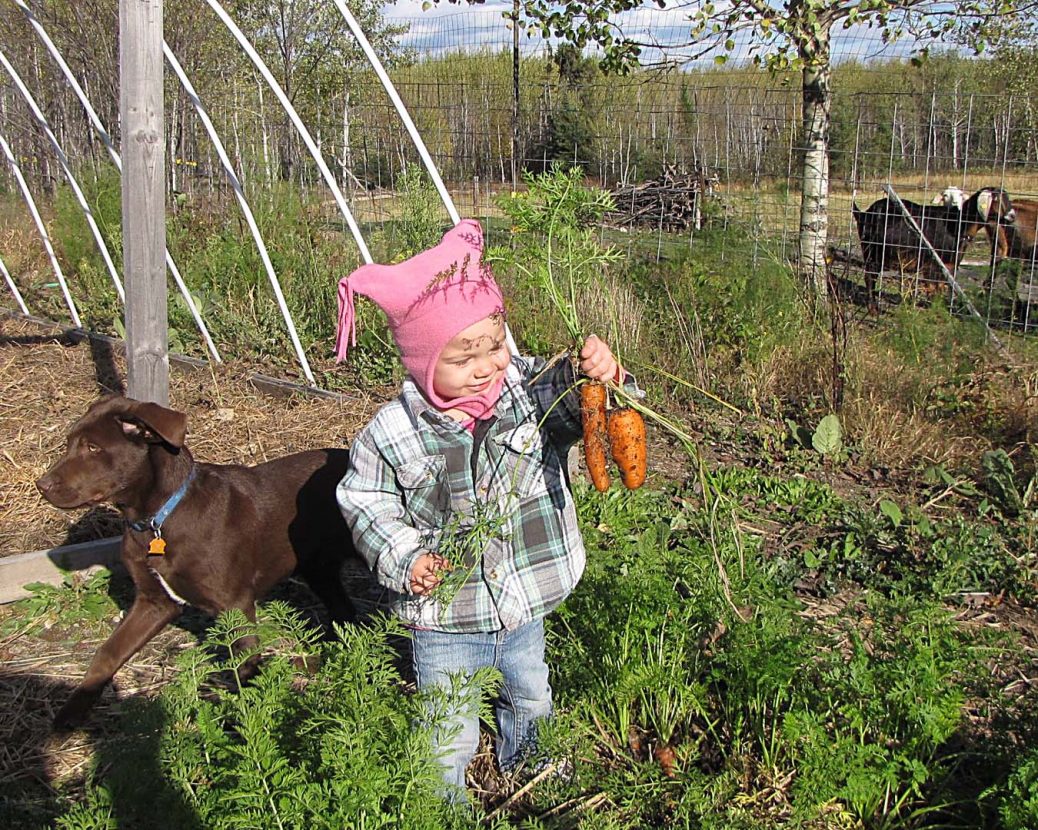By Jackie Clay-Atkinson
Most of us love carrots, and those of us who know how good parsnips taste love them too. But over and over, I hear people say their rows either didn’t come up or that they never got a decent crop. Carrots and parsnips have gotten a reputation as being hard to grow. Because of that reputation, a lot of folks have just stopped trying to raise them.
These folks that have given up marvel at our lush rows of carrots and parsnips, demanding to know how we even got them to come up at all. In reality, it’s no secret. We’ve found out how to grow them easily, with no tricks involved.
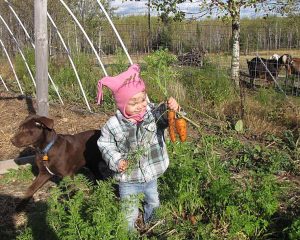
Our granddaughter, Ava, showing her nice big carrots to everyone.
Improving the soil
Although I’ve grown these root crops for decades, there have been times when they weren’t the best in the world. The most outstanding example was when we had first moved to our farm in Sturgeon Lake, Minnesota, in 1971. There was a big garden plot to the east of the house, but that plot was solid red clay, all the way down to hell. You’d think that after being a farm with dairy cattle for nearly 70 years the garden soil would be terrific and extremely fertile — not so. I don’t think any manure had ever been tilled into that soil.
I managed to till the ground in the spring and plant my garden, including carrots and parsnips. All summer I carefully weeded, watered, and thinned. Come fall, the ground was so hard that I couldn’t even get a shovel or spading fork in the ground to dig out my root crops. I actually had to hook up a plow and plow out my carrots and parsnips!
And what a “crop” that was; my carrots were nice and fat, but only four inches long. They hadn’t been able to penetrate the hard ground in order to grow.
Over the years, I hauled bags of leaves and other organic material onto the garden, as well as tons of the nice, black, rotted manure from out by the barn. And when we finally left, the soil was black, deep, and fertile. When I harvested my last crop, those carrots were a foot long, tender, and crisp.
The moral to that story is that root crops, especially long-growing ones like carrots and parsnips, like loose soil, not hard-packed clay. If you have clay, don’t despair; just begin to add lots of compost and rotted manure and keep at it. Make sure your manure is rotted though because adding fresh manure, which has too much nitrogen for root crops, will cause the roots to become hairy. We use our most rotted manure on the spots our root crops will be planted the next spring and our “hotter” or more fresh manure heavily on areas where our heavy feeders such as corn and squash will be planted. We are generous in our application as our soil is very poor, being sand and gravel with abundant big rocks, which we hand pick every year. In only seven years, our soil has gone from sand and rocks to nice black, loose dirt with good water-absorbing capabilities.
Varieties of carrots and parsnips
There are a lot of carrot varieties to choose from. We prefer the old-time heirloom varieties for our garden. They are open-pollinated so we can save our own seeds. And they’ve been around for generations because they grow well, taste good, and can or freeze great too. If you have good, loose soil you can plant any variety you like. Some of our favorite long carrots are Imperator and Kuroda (which grows not only long but very fat, too). But if your soil is still heavy and dense, you might be better off sticking with shorter carrots such as Danvers Half Long or Red-Cored Chantenay. As our soil is still improving, I often plant Nantes as it’s sort of a blend between longer carrots and the shorter, fat varieties. It grows long but is husky and can get pretty large — nice for stews and great to can up. For smaller sized carrots, just pull them earlier.
I don’t worry about how long a season my carrots need to mature. They take freezing and frost with a smile so they can easily finish up in the fall with no problems.
Planting
Most folks plant their carrots and parsnips very early in the spring because they can handle some frost and cold weather. It’s true that the seeds can germinate in fairly cool soil but the cooler the soil is, the longer it takes them to come up.
Unfortunately, weed seeds germinate a whole lot faster in cool soil, leaving your newly-planted carrot and parsnip rows covered with weeds that are hard to pull up without also pulling up or damaging your barely germinated vegetable seeds. And before your tiny carrot seedlings emerge, the weeds between the plants are huge in comparison, making getting rid of them without damage to the carrots nearly impossible. (Carrot seedlings look like tiny grass seedlings that fold over, one blade one way, the other in the opposite direction. They don’t look at all like carrot leaves!)
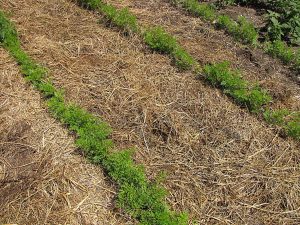
Two rows of carrots in a permanent mulched garden; simply rake the mulch back a couple of days before planting, then plant. When the carrots are a few inches tall, tuck the mulch back next to the rows.
We wait and plant our carrots and parsnips when the soil is a little warmer. In that way, the seeds germinate much faster, often in as little as a week to ten days, instead of three weeks like when they have been planted in cold soil.
Before planting your carrot and parsnip seeds, take time to till the soil so that it is nice and smooth, not just big chunks. If you do have some chunks, gently rake them to the side. Emerging carrot and parsnip seeds like nice, small-particle soil to begin growing in. For those of you who use a permanent mulch in your gardens, gently rake the mulch back where you will plant your carrot and parsnip seeds a day or two before planting to let the soil warm up a bit. With a hoe, make your row about an inch deep, taking time to break up any chunks of soil.
Do not plant carrots and parsnips deeply; they should only be planted about ¼-inch deep. Planting them too deep will result in poor germination.
Carrot seeds are miserable to plant; they are very small. Luckily, parsnip seeds are much bigger and, therefore, much easier. A lot of people get into trouble by dumping seeds out of packages down the row, resulting in not only a waste of seed but a tangled mass of seedlings that are darned near impossible to thin. (Remember that carrot seedlings are very small.)
And, of course, picking out one seed at a time is terribly time-consuming. What I do is pour out a few seeds into my palm then pinch out a few and gently sprinkle them as evenly as I can down the row. Repeat until the row has been planted.
Some companies, such as Johnny’s Selected Seeds, offer pelleted carrot seeds. These are coated with a water-soluble clay and are about the size of a radish seed. They are white, and are much easier to see and handle while planting. But they do cost much more than un-pelleted seeds. Some folks buy seed tapes for their carrot seeds. This does work, but it also costs much more per seed or per row. I’m cheap and use untreated carrot seeds and just take my time planting. It works well for me.
Parsnip seeds, being much bigger (they are flat, like hollyhock seeds), are easier to sow. You should plant them so that they are about ¼ inch apart down the row. Later you will be thinning them but you want the initial planting this thick so that if some seeds do not germinate you won’t have gaps in your row.
Once planted, gently cover your rows with nice light soil and pat it down all along the row, ensuring that there are no air pockets in the row that would kill newly-germinated seeds.
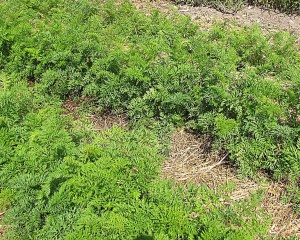
I often plant my carrots and parsnips in double rows about six inches apart to save space in the garden.
Be sure to keep your carrot and parsnip rows well watered even before they come up. Especially before they come up. I think that this is the one reason most folks have problems with carrots and parsnips. Those emerging tiny plants are so tender that even a few hours of dryness will kill them before they sprout above the soil. You don’t want the rows mushy with mud, but you do want the soil damp.
In about a week to two weeks, you’ll be able to see rows of tiny plants. The carrot seedlings look like two flat, slender folded leaves, like open hands; parsnip seedlings emerge with roundish leaves with many lobes.
Thinning
Thinning carrots (and parsnips) is one of my least favorite garden chores. I hate killing all those tiny little plants. When I was young I even tried to transplant them so I would be able to save their little lives. It never worked. But even now, decades later, I still can only thin for about 15 minutes before I have to take a break.
But it has to be done. Without thinning, carrots and parsnips never do well. The leaves may look good but the roots cannot develop. You’ll end up pulling handfuls of leaves and only tiny roots in the fall.
Instead of this, bite the bullet and thin your rows. I thin in steps. First, when the plants have about two sets of “real” leaves, I go down the row and thin the plants to stand about an inch apart. Then during the summer, when the carrots and parsnips are just starting to show a long root when you pull one, I thin them again — this time, to stand about two inches apart.
As summer progresses, I thin down the rows, picking a few baby carrots and parsnips for summer meals, finally leaving them to stand about two and a half inches apart or a bit more, depending on the size of the mature root. Again, this thinning is essential for growing a good crop.
At our homestead, it’s all about food. I don’t want hundreds of tiny carrots and parsnips. I want less, but much larger, mature roots for our meals.
As both carrots and parsnips are made up of a lot of water, you want to make sure both of these crops receive adequate water all summer, into the fall. If you have good soil and it holds water quite well, rainfall of an inch a week is generally adequate. If not, be sure to water periodically so they not only continue growing well but do not become tough and bitter.
Our carrots were so crisp this fall that as I’m scraping them in preparation to canning, they actually pop open in my hands. It shows me just how crisp and juicy they are.
Harvesting
If you’ve been “sneaking” a few carrots and parsnips from your rows in the late summer for family meals, you have a good idea of how big they are growing. To lessen the rush at harvest time, I often pull a few carrots early to dice up and can with some of my vegetable mixtures. Some of our favorites are diced carrots and peas, diced carrots and sweet corn, pickled baby carrots, and a mix of potatoes, onions, carrots, and rutabagas. These early-pulled carrots are taken out of the row as “thinning,” — one here, one there — to further space the carrots in the row.
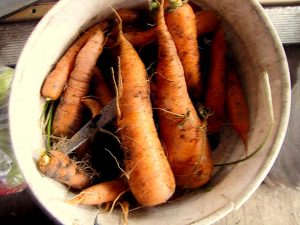
Here’s a bucket of carrots waiting to be canned.
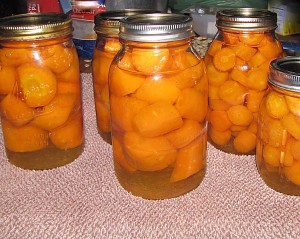
Some of the carrots I’ve recently canned; large chunks for roasting and stews, others are sliced
Parsnips are slower growing than carrots and usually are left in the ground until late fall.
Carrots and parsnips are not bothered by either frosts or freezing, so don’t worry about pulling them when your frost-tender vegetables must be hurried out of the garden when a freeze is predicted. In fact, in many more mild-winter areas, they can be left right in the ground to be pulled all winter, when just covered with a little straw so the ground won’t freeze and keep you from pulling them. (In mild climates, carrots and parsnips will often get hairy roots during the winter, preparing to go to seed the next spring.)
As carrots and parsnips become mature in size and the fall is getting colder, it’s time to pull them. (A few frosts and freezes actually make these root crops even sweeter.) They will both store quite well in a cool, dark spot that doesn’t freeze. Trim off the leaves, leaving about ½-inch of stems, then pack them snugly in a cooler with a top. Some folks pack them in sand, but we don’t do this and they store fine without the extra work.
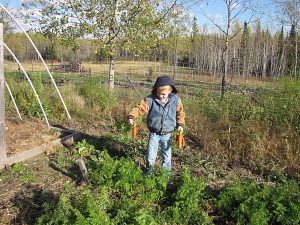
Our grandson, Mason, helping with the carrot harvest.
While we do store some for eating fresh during the winter, I can most of our carrots and parsnips so that they last over winter, and for years to come. Some I slice, others are diced. The biggest ones are cut into large chunks to use with a roast or in stews. Both are very easy to can, parsnips requiring only 30 minutes (pints) or 35 minutes (quarts) and carrots, 25 minutes (pints) or 30 minutes (quarts) at 10 pounds pressure. Note: If you live at an altitude above 1,000 feet, consult your canning book for directions on increasing your pressure to suit your altitude.
Following these easy tips, I’m sure you can raise tasty, bountiful carrots and parsnips every year.

